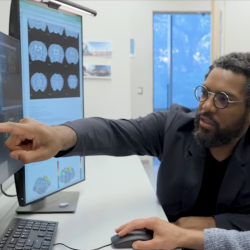Study Advances Understanding of Immune System’s Crucial Role in Phage Therapy
A new study co-authored by University of Maryland biologist Joshua Weitz assessed the potential for phage therapy to help treat antibiotic-resistant pneumonia.
As antibiotic-resistant “superbugs” make infections trickier to treat, some in the medical community are turning to bacteriophages for backup. Also known as phages, these viruses exclusively target bacteria, allowing them to tackle bacterial infections when introduced to a patient’s body.

While the use of phage therapy as an alternative or complementary treatment to antibiotics is growing, much is still unknown about how these viruses interact with bacteria and the immune system. A new study jointly led by the teams of Joshua Weitz at the University of Maryland and Laurent Debarbieux at the Institut Pasteur sheds light on this complex interplay.
Published in the journal Nature Communications on July 1, 2025, their research assessed the effectiveness of phage therapy in treating pneumonia. What they discovered about the mechanisms behind phage therapy could inform treatments in clinical settings to help patients facing similarly stubborn infections.
“There is an increasing number of bacterial infections for which antibiotics fail, leading to worrisome projections of very large numbers of hospitalizations and fatalities because we're running out of options to treat multi-drug resistant superbugs,” said Weitz, a professor in UMD’s Department of Biology and Institute for Health Computing (UM-IHC).
In their study, the researchers introduced phage to animal models to investigate their effectiveness in alleviating an acute pneumonia infection caused by Pseudomonas aeruginosa, a type of bacterium that lives in natural environments and causes opportunistic infections, leading to tens of thousands of hospitalizations and thousands of fatalities annually in the U.S. alone.
“In a therapeutic context, phage diffuse and come into contact with bacterial pathogens,” said Weitz, who also holds the Clark Leadership Chair in Data Analytics. “The premise of phage therapy has been that adding phage that specifically target and kill pathogenic bacteria can lead to infection clearance, but the reality is more complicated.”
In a test tube in a lab setting, phage and bacteria contacts can lead to a rapid collapse of the bacterial population. In contrast, in an animal or human host, the proliferation or collapse of a bacterial population depends on the efficiency of phage killing and the response of the immune system. Ultimately, this “immunophage synergy” is pivotal for the success of phage therapy, Weitz explained.
However, experiments in animal models revealed a surprising complication: Immunocompromised animals with depleted levels of alveolar macrophages—the most abundant immune cells in the lungs that serve as critical first responders to infection—responded better to phage therapy.
Debarbieux said they initially expected that all immune cells would work with phage to tackle the infection.
“While alveolar macrophages are protecting the lungs from pathogens, their presence surprisingly hampers the efficacy of phage therapy,” Debarbieux said.
To understand why this was happening, the researchers used in vivo experiments performed by first author Sophia Zborowsky and colleagues at the Institut Pasteur and a mathematical model developed by Weitz’s group to represent the feedback between immune cells, bacterial pathogens and therapeutic phages.
Former Weitz group postdoctoral associate Jeremy Seurat, the study’s first co-author, and UMD biology postdoctoral associate and study co-author Jacopo Marchi designed this model, which revealed that alveolar macrophages were depleting the phages and lowering their chances of reaching bacteria.
“We showed that alveolar macrophages engulf phage,” Debarbieux said. “In other words, an immunocompromised situation paradoxically leads to an increase in the number of phage available to kill the bacterial pathogen.”
These findings underscore the importance of the immune system in phage therapy. When transferred to a clinical setting, this means that physicians could someday include personalized data on a patient’s immune system to better tailor the use of phage therapy.
“Moving forward, this research may help inform the eligibility criteria of patients and design therapeutic strategies to leverage the positive while avoiding the negative feedback of immunophage synergy,” Weitz said.
The next steps of this research could involve building predictive models to better estimate the effectiveness of phage therapy under different conditions. This aligns with the UM-IHC’s goal of using advanced computing to develop novel therapies.
“The study shows how computing can be a partner in advancing and accelerating health discoveries,” Weitz said. “In this case, using computational models can help us understand the levers driving phage-immune feedback as a means to accelerate the translation of phage therapy in clinical settings.”
###
The paper, “Macrophage-induced reduction of bacteriophage density limits the efficacy of in vivo pulmonary phage therapy,” was published in Nature Communications on July 1, 2025.
This research was supported by the U.S. National Institutes of Health (Grant No. 1R01AI46592-01), the Conseil Régional Ile de France Chaire Blaise Pascal and Agence Nationale de la Recherche (Grant No. ANR-19-AMRB-0002). This article does not necessarily reflect the views of these organizations.







